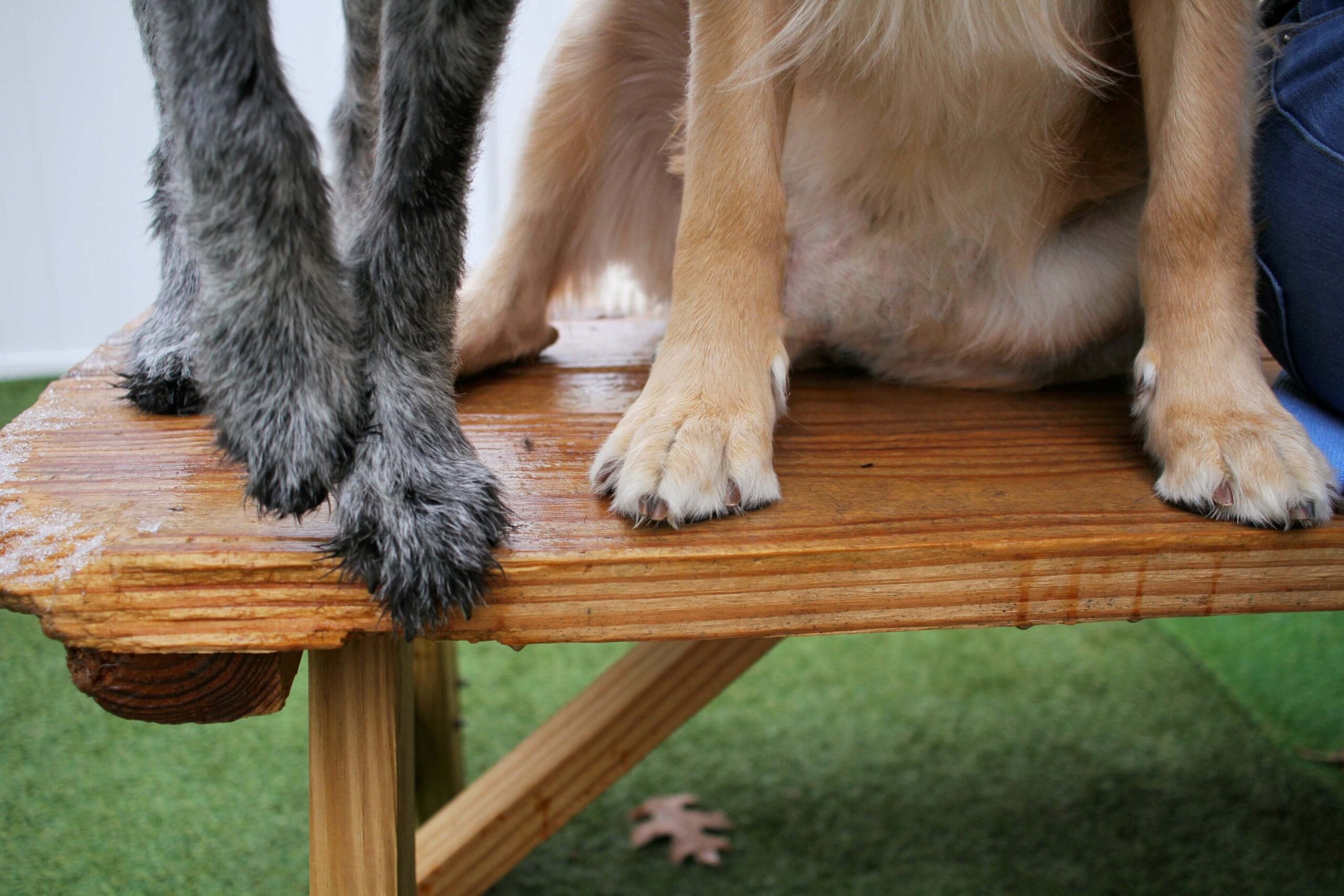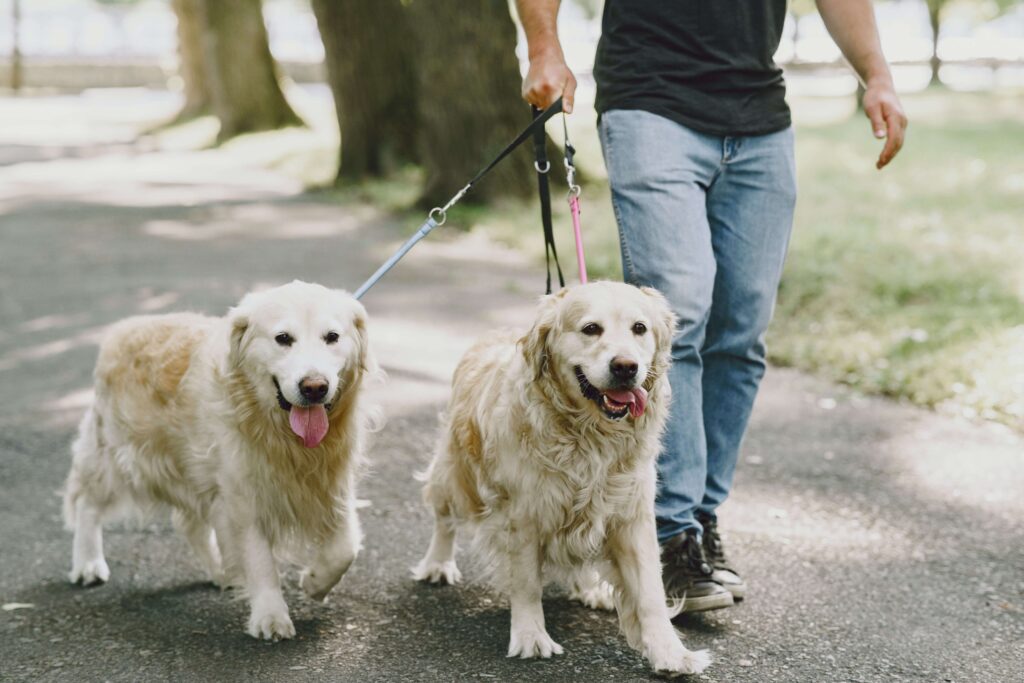Find Tips & Tools
to understand your dog better
How to recognize joint pain in older dogs: Early Detection for Timely Intervention

Watching your four-legged companion slow down can be a heart-wrenching sight. Joint pain is one of the most common age-related issues dogs face, making those once effortless walks a bit more challenging. But fear not, fellow dog lovers! With the right knowledge and care, you can help your canine pal navigate their golden years with ease and comfort.
Importance of Recognizing Joint Pain in Older Dogs
Joint pain can put a damper on your furry friend’s zest for life, making those once-favorite walks a distant memory. But it’s not all about the visible signs of discomfort; recognizing joint pain early on is about understanding the overall well-being of your beloved hound.
Benefits of Early Detection and Timely Intervention
Early detection of joint pain allows for immediate intervention. Treating joint pain at its early stages mostly leads to:
• Decreased progression of the disease
• Preventing unnecessary suffering
• Improved overall health and quality of life for your pet
Understanding Joint Pain in Dogs
As our beloved canine companions age, joint pain becomes an unwelcome guest, often slowing them down and dimming their playful spirits. But as responsible pet parents, we can turn the tide against this common issue by recognizing the signs early on and providing the right support.
Common Signs And Symptoms Of Joint Pains
Joint pain can put a damper on your dog’s vibrant spirit, turning those once-loved walks and playtime sessions into distant memories. This lack of activity, combined with the discomfort, can lead to a few unwelcome visitors: extra pounds, thanks to reduced calorie-burning, and mood swings, including increased irritability or sadness. But by identifying and addressing joint pain early on, you can help your furry friend reclaim their zest for life and make the most of their senior years.
Behavioural Changes to Look For
Your furry friend might not be able to express their aches and pains in words, but they’re sure to find other ways to communicate their discomfort. One of the first signs you might notice is a change in their enthusiasm for activities they once loved. Gone are the days of chasing other dogs with reckless abandon or eagerly joining you for a brisk walk. Instead, your once-energetic pup might prefer to lounge on the couch, catching up on some much-needed snooze time. And if you try to offer a gentle pat or stroke, they might flinch or even snap, expressing their discomfort in no uncertain terms. If your dog’s social life has suddenly taken a nosedive, or they seem to be perpetually shrouded in a cloud of canine melancholy, joint pain could be the culprit behind their change in demeanour.
Common Signs And Symptoms Of Joint Pains
Joint pain can put a damper on your dog’s vibrant spirit, turning those once-loved walks and playtime sessions into distant memories. This lack of activity, combined with the discomfort, can lead to a few unwelcome visitors: extra pounds, thanks to reduced calorie-burning, and mood swings, including increased irritability or sadness. But by identifying and addressing joint pain early on, you can help your furry friend reclaim their zest for life and make the most of their senior years.
Behavioural Changes to Look For
Your furry friend might not be able to express their aches and pains in words, but they’re sure to find other ways to communicate their discomfort. One of the first signs you might notice is a change in their enthusiasm for activities they once loved. Gone are the days of chasing other dogs with reckless abandon or eagerly joining you for a brisk walk. Instead, your once-energetic pup might prefer to lounge on the couch, catching up on some much-needed snooze time. And if you try to offer a gentle pat or stroke, they might flinch or even snap, expressing their discomfort in no uncertain terms. If your dog’s social life has suddenly taken a nosedive, or they seem to be perpetually shrouded in a cloud of canine melancholy, joint pain could be the culprit behind their change in demeanour.
Changes in Mobility and Activity Levels
Monitor closely for changes in your dog’s mobility and activity level. Their once-sprightly jumps might now be replaced with hesitant attempts, and climbing stairs might seem like an insurmountable task. And if you notice a limp or a slower gait, it could be a sign that their joints are sending out distress signals.
So, keep an eye out for any changes in their mobility – if they’re suddenly reluctant to join you on your daily hikes or prefer a leisure stroll over a brisk jog, it could be their joints signalling for a break. Remember, joint pain doesn’t have to mean the end of your dog’s adventurous spirit. With a little TLC, the right care tools and a visit to your vet, you can help your furry friend rediscover one pain-free step at a time.
Difficulty Getting Up or Lying Down
Another clear indicator of joint pain can be seen when your dog has difficulty getting up or lying down. If your dog seems to be struggling with these simple movements or takes a bit longer to settle into a comfortable sleeping position, it could signal that joint pain is present. Look out for these signs, and don’t hesitate to seek veterinary help if you suspect your dog is hurting.
How Can You Examine and Assess Joint Pain
Assessing joint pain in older dogs involves a detailed physical examination. By performing specific tests, you can recognize any discomfort your furry friend might be experiencing.
Palpating the Joints
Palpation involves gently feeling your dog’s joints to detect abnormalities such as swelling, heat, or tenderness. It would help if you palpate all the joints – from the shoulders and elbows to hips and knees. Ensure your dog is relaxed during this process as tension can mask symptoms. Here are the things you should look for:
- Swelling or enlargement of the joints
- Any signs of discomfort while pressing gently on the joint
- Unusual heating sensation
Range of Motion Tests
The next step involves assessing your dog’s range of motion. This could mean gently flexing and extending your dog’s legs to check for any resistance or signs of pain. Check each joint individually and note any noticeable differences compared to its ‘normal’ movement.
Evaluating Gait and Posture
Finally, evaluating your dog’s gait and posture can provide critical insights. Observe their walking, running, and getting up from a lying position. Limping, reluctance to move, and changes in posture are often tell-tale signs of joint pain. Dogs with joint pain may also have an abnormal stance – such as leaning more to one side.
Diagnostic Tests for Joint Pain in Older Dogs
If you’re noticing some signs and symptoms, it is natural for you to wonder, what are tests my dog can do to determine whether he/she is having any joint issues. Having an idea of the various diagnostic tests for joint pain in older dogs would greatly speed up the intervention process. Let’s delve into the following specific tests.
X-rays and their role in diagnosing joint pain
X-rays are a common diagnostic tool used in assessing joint pain in older dogs. They provide a clear image of your dog’s bone structure, allowing your vet to identify any abnormalities, fractures, or deformities that may be causing discomfort. It’s a non-invasive procedure and can provide immediate results.
Blood tests to rule out other underlying conditions
Blood tests may also be conducted to rule out other potential causes of your dog’s pain like infections, cancers, or organ diseases. A complete blood count and biochemical profile will help determine the overall health of your pup and point to any non-joint related issues that might need addressing.
Joint fluid analysis for more accurate diagnosis
A joint fluid analysis may be the best route for a more accurate diagnosis. This involves the collection of a small sample of the fluid in your dog’s joint, which is then examined under a microscope. This test can help identify infection, inflammation, or degenerative joint disease – giving you a comprehensive picture of what’s causing the pain. Remember, the earlier these conditions are detected, the better they can be managed, thereby improving the quality of life of our beloved canine companions.
Common Joint Conditions in Older Dogs
Knowing how to spot potential joint problems and what tests involved in identifying joint-related issues, I’m guessing you’ll also be curious to find out what are common joint issues that are more prevalent in older dogs. Joint pain in our four-legged friends is often caused by osteoarthritis commonly known as arthritis in the medical world of dogs, which are like unwelcome guests that gradually wear down their joints. This condition is more common in older dogs, and it’s often made worse by being overweight, working too hard, or getting injured. Additionally, some breeds are more likely to have joint problems than others.
Osteoarthritis in Dogs: Causes, symptoms, and treatment options
Osteoarthritis is an ailment that is unfortunately quite common among older dogs. Caused by the slow wear and tear of the joint cartilage, symptoms can include stiffness, unwillingness to play, and visible discomfort when walking or running. Treatment options can range from medication prescribed by your vet to dietary changes and low-impact exercises. Maintenance of pain caused by osteoarthritis in dogs can be regulated with anti-inflammatory and joint cartilage repair supplements.
Hip dysplasia: Signs and management strategies
Hip dysplasia, another common condition, is caused by an improperly formed hip joint. Signs can include a noticeable limp and difficulty when attempting to stand or climb stairs. Management strategies often include weight management, hydrotherapy, anti-inflammatory supplementation and sometimes surgical intervention when needed.
Degenerative joint disease: Understanding the progression and treatment
Degenerative joint disease is a slow progression of cartilage erosion resulting in bone rubbing on bone. This can cause severe discomfort and lameness over time. Treatment can include medication for pain relief and inflammation plus implementing supportive care such as orthopaedic beds and slow, steady exercise routines.
Preventive Measures for Joint Pain in Older Dogs
If your dog does not show any signs or symptoms yet, that’s awesome news. Keeping your older dogs mobile and happy involves preventive care approaches. These measures can help stall the onset of joint pain, or at least, lessen its impact.

Appropriate Exercise and Weight Management
One primary way to prevent joint pain in your beloved canines is by managing their weight and ensuring they get the right amount of exercise. Too much weight puts unnecessary stress on their joints, potentially leading to pain. Appropriate activities can include:
- Regular walks but not too strenuous
- Allowing swimming if possible, as it’s gentle on the joints
- Games that aren’t high impact, like fetch with a soft toy instead of jumping activities
Providing a Nutritious Diet for Joint Health
Diet plays a substantial role in maintaining good joint health. Reward your older dogs with a balanced, nutritious diet full of proteins and foods rich in omega-3 fatty acids which are known for their anti-inflammatory properties.
Joint Supplements for Preventive Care
Incorporate joint supplements into your older dog’s routine. Always consult with a vet before starting your dog on any new medication or supplement. Even with preventive care, always watch for signs of joint pain in dogs. Your early detection paves the way for a timely intervention. Check out our recommended hip & joint supplements for senior dogs here.
In the intricate tapestry of our canine companions’ lives, deciphering the subtle signals of joint discomfort becomes an act of unwavering devotion. The subtle signs – the hesitant rise, the occasional limp, the quiet withdrawal – are their silent pleas for intervention. Through methods like joint palpation, gait assessment, and vet consultations with diagnostic tests, we decode the language of discomfort. As we confront the trio of osteoarthritis, hip dysplasia, and degenerative joint disease, our commitment to preventative measures becomes a potent script for a vibrant canine life. For those blessed with seniors yet untouched by joint afflictions, the call to action echoes urgently. Engage in proactive measures – from mindful exercise and weight management to a nourishing diet and the introduction of joint supplements – as the pillars of a legacy where our dogs revel in the twilight of their years, agile and pain-free. In the art of preventative care, we gift our loyal companions not just longer lives but richer, bound by the threads of love and well-being.


